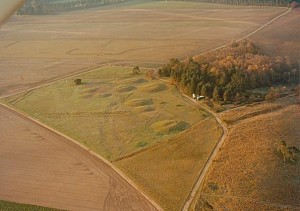These pages are intended as a focus for those interested in the royal burial mounds of Sutton Hoo in south-east Suffolk. It is widely believed and it seems most likely (no serious argument has ever been mounted to cast any doubt on the view) that this was the burial-place of the Wuffings during the late sixth to early seventh centuries.

Cliff Hoppitt’s aerial photograph of Sutton Hoo, taken early one morning on 29th November 1983 with pilot John Griffiths at the controls (©Cliff Hoppitt).
The most famous of the Sutton Hoo burial-mounds is Mound One, which was excavated in 1939 and found to contain the remains of an undisturbed treasure laden ship, the funerary vessel of an early seventh-century Wuffing king. In the burial chamber amidships lay one of the greatest treasure-hoards ever discovered in archaeology, including the gold and cloisonné regalia of a warrior-king, silver feasting equipment, and other wonders.
The Mound One ship-burial revealed an unexpected world of wonder at the dawn of the story of England, which has led to a major revision in our understanding of the origins and early history of the Wuffing kingdom. It is believed by many to be that of King Rædwald, the greatest of the kings of the Eastern Angles and overlord of Britain from c.617 until his death c.625.
For a tour of some of the wonders of the royal war-gear, which helps reconstruct the king’s appearance, click on the headings below (British Museum pictures used with the blessing of the late Dr Rupert Bruce-Mitford).
The Discovery
The Ghost-Ship of the Wuffings
The Royal Burial-Chamber
The Royal Sword Blade
The Royal Sword Hilt
The Royal Sword Belt
The Royal Money Belt
The Royal Shoulder Mounts
The Royal Helm
The Royal Shield
The above entries are based primarily on the authoritative report by Rupert Bruce-Mitford, The Sutton Hoo Ship Burial, 3 vols (British Museum 1975, 1978, 1982) and the more recent handbook by his successor, Angela Care Evans, The Sutton Hoo Ship Burial (British Museum 1986). Rupert Bruce-Mitford’s Aspects of Anglo-Saxon Archaeology (London 1974) is also very useful.
There is much more to the wonders of the royal vessel from Mound One than I describe here, which are largely those immediately associated with the royal body – the regalia of a warrior-king. There is also the sumptuous feasting equipment, which includes silver plates, bowls, spoons, drinking horns, cups, a great iron-bound, yew-wood vat (estimated to have held about 178 pints), and the king’s harp. As well as that, there are also several mystery objects, such as what appears to be a ceremonial whetstone, sometimes referred to as a sceptre.
The treasures from the Sutton Hoo ship-burial can be seen in the British Museum or on their website.
The National Trust Visitors’ Centre at Sutton Hoo
The National Trust Visitors’ Centre at Sutton Hoo was opened in March 2002. This has made the site and its story more accessible than ever before and is a huge asset to Sutton Hoo studies.
However, I have had to query the wisdom of the some of the contents of the exhibition building at times – for example, several of the prominent paintings by Kelvin Wilson.
The Mound 17 horse and rider, for example, depicted with what appeared to be a Native American horse ridden by an arrogant hippy. For some reason, this image was in the background of the painting, the foreground being dominated by what looks like a pair of peasants. The artist appeared to have assumed that the working classes had been excluded from Sutton Hoo and so had sought to compensate by foregrounding these two ‘forgotten’ figures. The painting thus seemed to have little to do with attempting to authentically reconstruct the horse and rider from Mound 17, surely one of the richest and most interesting horse-and-rider burials ever discovered on the island of Britain. It seemed to be more about projecting a rather superficial political view of our past which is still fashionable in some quarters despite being lampooned with great comic effect in a memorable scene in Monty Python’s Quest for the Holy Grail, where Arthur’s legendary kingship is questioned by a muddy peasant using the jargon of the students’ union bar.
I also had grave doubts about the huge painting of the hanged man, which seemed unnecessarily obtrusive by the door of the treasure-room – and why was there a sort of abbot by the gallows? After Professor Carver eventually accepted that the so-called “execution burials” which he excavated were part of a separate chapter of the site’s history, this painting should have been removed.
Nevertheless, the exhibition was well worth a visit. Among many other good things (such as the treasure room, the replica harp, the recordings of music and Old English poetry, or the Mound 17 horse harness and fittings) , its centre-piece was the a superb full-scale reconstruction in oak of the midsection of the ship and the burial-chamber (though the shop-dummy lying on the deck looked very unlike a king lying in state).
However, all this has been recently changed. Although I welcome the removal of the paintings discussed above, it remains to be seen whether or not it is an improvement on the old one.
The currently arranged opening times of the National Trust Centre can be seen on the National Trust Sutton Hoo webpage.
Also within my Sutton Hoo Pages:
1. Echoes of Lost Literature at Sutton Hoo
2. What Literature Reveals about Beliefs Associated with Royal Burial Mounds
3. In Defence of the Wuffings: My Review of Martin Carver’s Book Sutton Hoo: Burial Ground of Kings?
© Copyright Dr Sam Newton AD 2000, 2013, 2020


